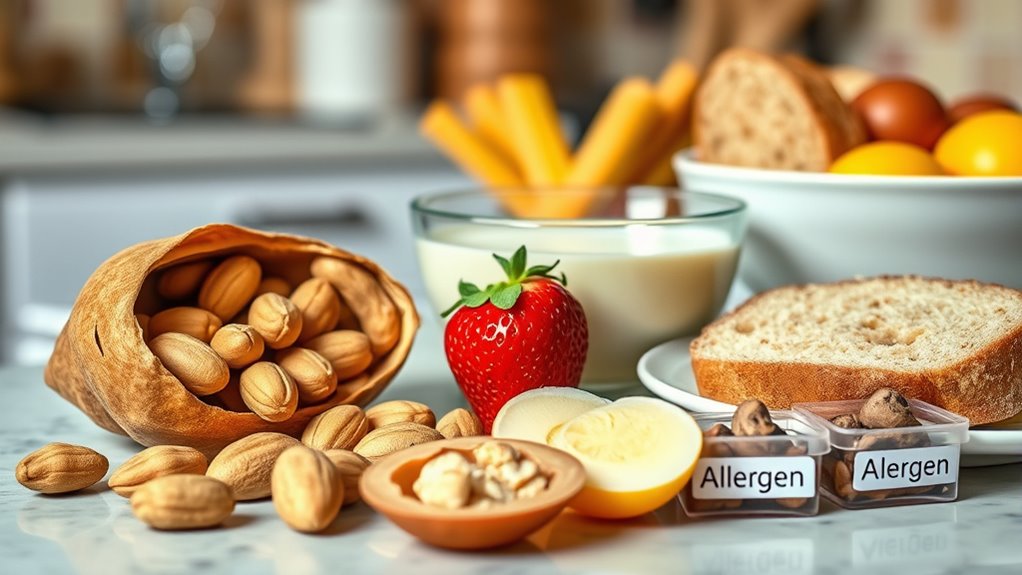To introduce allergenic foods safely, start gradually and in controlled settings, observing for reactions. Consult your healthcare provider to identify possible cross-reactivities and get personalized advice. Always carry emergency medications like epinephrine and be aware of severe allergy signs. Read labels carefully, keep detailed reaction records, and inform those around you about your allergy plan. If you’re curious about more tips to ensure safe and confident food introductions, there’s plenty to explore.
Key Takeaways
- Consult with healthcare providers to identify potential cross reactivities and develop a personalized food introduction plan.
- Introduce allergenic foods gradually, starting with small amounts under medical supervision.
- Always read labels carefully and ask about ingredients when dining out to avoid unexpected allergens.
- Monitor for and recognize allergic reactions promptly; carry emergency medications like epinephrine auto-injectors.
- Keep detailed records of reactions to identify triggers and adjust the diet accordingly for safety.

Food allergies affect millions of people worldwide, and understanding them is essential for safety and well-being. When you’re introducing allergenic foods, it’s crucial to be aware of potential cross reactivity issues. Cross reactivity occurs when your immune system confuses similar proteins in different foods, leading to allergic reactions even if you haven’t eaten the specific allergen before. For example, if you’re allergic to peanuts, you might also react to legumes like lentils or chickpeas because of their similar protein structures. Recognizing these cross reactivity issues helps you avoid unexpected reactions, especially during early exposure. It’s wise to consult with your healthcare provider or an allergist to understand which foods might pose a risk and to develop a tailored plan for safe introduction.
Emergency preparedness is equally vital. No matter how careful you are, accidental exposures can happen. Always have an action plan in place, which includes carrying your prescribed allergy medications, such as antihistamines or epinephrine auto-injectors. Make sure those around you know how to recognize signs of a severe allergic reaction and how to respond quickly. When you’re trying new foods, do so in a controlled environment, ideally with someone nearby who knows what to do if you experience symptoms. Keep emergency contact numbers handy, and consider wearing medical alert jewelry that indicates your allergies. Preparing for potential emergencies isn’t just about having medications on hand; it’s about being proactive in avoiding situations that could trigger a reaction and knowing how to react swiftly if one occurs. Understanding food allergy management strategies can significantly improve safety and confidence when introducing new foods.
Introducing allergenic foods requires patience and vigilance. Always start with small quantities, ideally under medical supervision, to monitor how your body reacts. Read labels thoroughly and inquire about ingredients when dining out, as hidden allergens can be present in unexpected foods. During initial introductions, keep a detailed record of your reactions to identify patterns and trigger points. Remember that cross reactivity issues might mean certain foods are off-limits even if you don’t have a history of reacting to them. Always prioritize your safety by being informed and prepared. Educate yourself on the symptoms of allergic reactions, which can escalate rapidly, and never underestimate the importance of quick access to emergency medications.
Frequently Asked Questions
How Do I Identify Hidden Allergens in Processed Foods?
To identify hidden allergens in processed foods, you should carefully read ingredient labels, as they often list common allergens explicitly. Pay attention to terms like “may contain” or “produced in a facility that processes,” which indicate potential cross-contact. Also, consider manufacturer practices; some brands are more transparent about allergen information. When in doubt, contact the manufacturer directly to clarify ingredient details and guarantee your safety.
Can Food Allergies Develop Later in Life?
Think of your immune system as a cautious gatekeeper. It’s possible for adult onset allergy development, meaning you might not have had allergies before but develop them later in life. Changes in your environment, diet, or health can trigger this. So yes, food allergies can develop later, and staying alert helps you catch new reactions early. Always consult a healthcare professional if you experience symptoms that suggest an allergy.
What Are the Signs of a Severe Allergic Reaction?
If you experience a severe allergic reaction, you might notice symptoms like difficulty breathing, swelling of the face or throat, rapid heartbeat, or dizziness. It is crucial to be prepared with emergency preparedness plans, such as carrying an epinephrine auto-injector. Additionally, allergen testing can help identify triggers, so you can avoid them. Recognizing these signs early saves lives, so stay vigilant and seek immediate medical help if needed.
Are There Any Natural Remedies for Food Allergies?
Seeking soothing solutions? While natural remedies like herbal supplements and alternative therapies may seem tempting, they often lack scientific support for food allergies. You should consult a healthcare professional before trying any herbal or alternative options, as they could cause adverse reactions. Remember, managing food allergies safely involves proven methods like avoiding allergens and carrying emergency medication, not relying solely on unproven natural remedies.
How Can I Ensure Cross-Contamination Is Avoided During Food Prep?
To avoid cross-contamination during food prep, focus on maintaining excellent kitchen hygiene. Always wash your hands, utensils, and surfaces thoroughly before and after handling allergenic foods. Use separate cutting boards and knives for allergen-free ingredients, and clearly label all foods to prevent mix-ups. Regularly cleaning your workspace reduces risks, ensuring allergenic foods don’t accidentally contaminate other items. These practices help protect anyone with allergies and keep your kitchen safe.
Conclusion
By following these simple steps, you’ll become a superhero in your child’s food allergy journey. Introducing allergenic foods safely might seem like a small task, but it can feel like the difference between steering a minefield or walking a peaceful path. Remember, your careful approach can prevent a life-threatening reaction and build your child’s confidence around new foods. Stay informed, stay cautious, and you’ll be amazed at how confidently you can keep your little one safe and happy.










